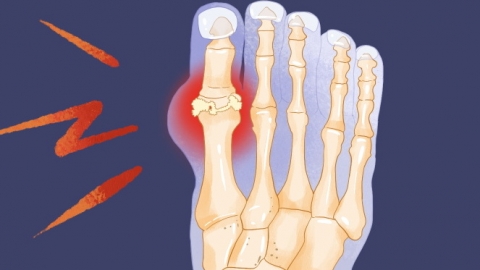How can gout crystals be eliminated?
Generally, the formation of gout crystals may be caused by long-term high-purine diet, insufficient daily water intake, asymptomatic hyperuricemia, acute gouty arthritis, chronic tophaceous lesions, and other factors. It is recommended to seek timely medical consultation, identify the cause, and improve the condition under a doctor's guidance through general treatment, medication, surgical treatment, and other approaches. A detailed analysis is as follows:

1. Long-term high-purine diet: Frequently consuming high-purine foods such as animal offal, seafood, and concentrated meat broth increases uric acid production from purine metabolism. When production exceeds excretion capacity, urate tends to deposit and form crystals. Adjust the dietary structure, reduce intake of high-purine foods, and consume more low-purine foods such as wax gourd, celery, and millet.
2. Insufficient daily water intake: A daily water intake of less than 1500ml prevents uric acid from dissolving sufficiently in urine, leading to deposition and crystal formation in joints and soft tissues. Increase daily water intake primarily through drinking boiled water or light tea, ensuring a daily intake of 2000-2500ml to promote uric acid excretion via urine and reduce crystal deposition.
3. Asymptomatic hyperuricemia: Uric acid levels remain persistently above the normal range, but symptoms such as joint pain do not appear. In this long-term hyperuric state, crystals gradually form. In addition to dietary adjustments, follow medical advice to use medications such as allopurinol tablets, febuxostat tablets, and benzbromarone tablets to lower uric acid levels.
4. Acute gouty arthritis: Urate crystals deposit in the joints, causing redness, swelling, and pain. Inflammatory responses during an acute attack can worsen crystal deposition. During an acute episode, follow medical advice to use anti-inflammatory and analgesic medications such as colchicine tablets, diclofenac sodium sustained-release tablets, and etoricoxib tablets.
5. Chronic tophaceous lesion: Poor long-term control of uric acid leads to significant crystal accumulation, forming hard tophi that may affect joint mobility. Smaller tophi can be dissolved through long-term uric acid-lowering therapy. Larger tophi or those compressing surrounding tissues may require surgical removal to clear crystals from joints and soft tissues. Continued uric acid-lowering treatment is necessary after surgery to prevent recurrence.
In daily life, avoid alcohol consumption, especially beer and white spirits, and reduce intake of high-sugar beverages. Maintain a regular作息 (sleep-wake cycle), avoid staying up late or overexertion, and engage in mild exercises such as walking or tai chi. Avoid strenuous exercise that may trigger gout, aiding in crystal elimination and condition stabilization.




